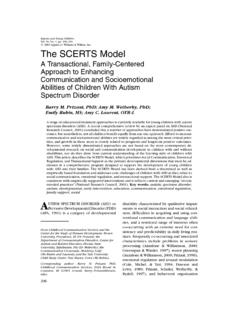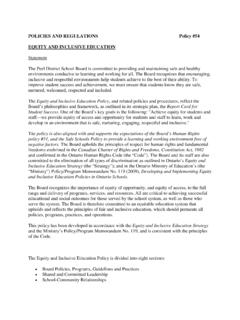Transcription of Inclusion Notebook Rev 6.12 - The scerts model
1 Problem solving in the classroom and communityVolume VI, No. 1 Spring 2007ON THE COVER: inclusive education and AutismEducating Children with Autism(page 2)A Tale of Two Students(page 3)Parent's Perspective (page 7)TIN Pull-out Pages: Models for Inclusion (pages 8-13)Q & A with the Staff of Great Neck School (page 14) The InclusionNotebookInclusive education and AutismIssuein thisThe Inclusion Notebook is produced twice a year and is a publication of the University of Connecticut Pappanikou Center for Excellence in Developmental Disabilities education , Research, and Service. For questions, comments, or corrections regarding this publication, please contact Kathleen Whitbread at (860) 679-1565. This issue of the Inclusion Notebook highlights the topic of teaching children with autism in the general education setting. In this edition we present educational models and practices that are designed to meet the unique needs of children with autistic spectrum disorder (ASD) in a manner that enables them to be educated in an inclusive setting.
2 Rather than focusing on treatment interventions designed to address isolated skill areas, we present information on educational approaches that serve as a framework for meeting the individual needs of students with ASD while in the regu-lar education classroom. We have included articles on the rationale for implementing inclusive models designed for students with ASD as well as articles on student experi-ences and parent perspectives regarding the inclusive education for their children with ASD. The pull-out section includes an overview of several different models that can be utilized to educate students ages three through adulthood using inclusive practices, as well as a summary of key components necessary in any inclusive program. Our Q and A section highlights one Connecticut school districts commitment to educating students with autism not only in the general education setting but in their neighbor-hood schools as Children with Autism Autism has become the fastest growing category of special education since it was added to the Individuals with education Act (IDEA) in 1990.
3 In the decade following its addition to IDEA, the number of students identified as having autism increased from 5,000 to over 118,000 (OSEP, 2004). Since that statistic was reported, the numbers have continued to grow almost exponentially. This has occurred as the result of several factors. First, the definition and diagnostic criteria for identifying autism has been expanded to include a range of abilities and presentations, and is now considered to be a spectrum of disorders. Essentially, three primary characteristics are recognized as defining autistic spectrum disorder (ASD): 1. deficits in social interaction 2. deficits in communication 3. restricted repertoire of interests and behaviors Second, the Committee on Educational Interventions for Children with Autism, National Research Council (2001) recommended that all children with a diagnosis of ASD should be eligible for special education services under the category of autism, regardless of their level of impairment.
4 Third, it has been proposed that investigation should take place to determine if the dramatic increase in the numbers of children served with autism has been offset by commensurate decreases in other categories into which children with ASD might have once been placed such as other health impairment, social and emotional disability, and developmentally delayed (OBrien & Daggert, 2006). The increase in the number of children with ASD and the range of abilities among those children has brought with it a host of questions and concerns on how to provide a free appropriate public education in the least restrictive environment to children on the spectrum. Over the years, a number of teaching methodologies have been proposed, including interventions that target specific areas such as relationship development, individual skill building, cognitive development and physiological processes.
5 Often these approaches are therapeutic in nature and focus on the acquisition of core social, communication and play or academic skills and take place in segregated settings. As children with ASD progress through the school years, those with more significant learning needs may experience a decline in the amount of time that they spend with same-aged peers participating in the general education curriculum. With the implementation of the No Child Left Behind Act of 2001 and the reauthorization of IDEA in 1997 and 2004, the emphasis on educating students with ASD in the general education setting has increased dramatically (Yell, 2003). As a result, some school districts have begun to look at structured models for inclusive education for students with ASD as an alternative to more therapeutically driven methodologies. The benefits of applying a structured framework for teaching students with ASD in inclusive settings include consistency across people providing support; organized instructional settings; smoother transitions between school-age programs (elementary to middle to secondary); a shared knowledge base among team members; improved family-school partnerships; and enriched social experiences for all students.
6 The Pull-Out Section of this edition features a description of several models used for teaching children with autism in inclusive educational settings including the scerts model , structured teaching, LEAP, and the Autism Spectrum Disorder Inclusion Collaboration model . These models offer a framework for facilitating the successful education of learners with ASD in the regular education classroom as well as other inclusive settings. Telephone (860) 679-1500 Fax (860) 679-1571 Inclusion NotebookPage 2 The Inclusion NotebookPage 3 Telephone (860) 679-1500 Fax (860) 679-1571 Tale of Two StudentsMaritza When you walk into Mrs. K s second grade classroom you are met with a typical scenario. Mrs. K is seated in a comfortable rocking chair reading a storybook to her to stu-dents who are quietly gathered around her, seated on a carpet that defi nes the boundaries of the meeting space.
7 Most of the students are attending; a few fi dget from time to time, shifting their weight or occasionally looking away from Mrs. K, noting that someone has just entered the classroom. One of the students, however, is looking away more than the others and mov-ing a little bit more than the others; her body is turned slightly away from the teacher, and she is holding a book in her hands. She is also not sitting directly on top of the rug, but rather she is sitting on a round rubber disk, about 10 in diameter that has a number on it. The student s name is Maritza and she has autism. When Maritza was a toddler, her parents were given the diagnosis; at that time the family was living in New York and as Marit-za moved into the realm of public school at the age of 3, all that the school district was willing to offer was to bus Maritza an hour each way to a special program for children with autism.
8 Martiza s parents refused to have her segregated; rather than fi ghting the school district, they moved to Waterford, CT to be near family and to provide Maritza with the opportunity to at-tend school with typically developing children. While Maritza s parents did not realize it at the time, their new school district was busy preparing to improve its ability to educate students with autism. The goal was to adopt a framework called the scerts model that would enable the district to not only educate stu-dents with autism within the district, but to do it in such a way that students could attend their neighborhood school, and be taught in the regular classroom. Marizta has been able to benefi t from the implementation of the scerts model to such an extent that she is able to be in the classroom all day, learning alongside her peers, despite her diagnosis of autism.
9 Like many individuals with autism, Maritza does not speak conversationally, she does not engage in age-appropriate social interaction with peers, and she does not have a typical or expanded repertoire of interests for her age. Contrary to what was once considered typical for children with autism, Maritza does have a desire to communi-cate, she does have an interest in her classmates and she does want to participate in a number of activities. Barriers to her achieving these ends, however, lie in the diffi culties that Maritza experiences in social communication (SC); emotional regulation (ER) and transactional sup-port (TS). Put them all together and they spell scerts , the model that was adopted by the school district. What you see when you look at Maritza during story time is the scerts model in action. To support her participation, Maritza has specifi c objectives for the lesson that are based on the scerts model .
10 The social communication objective for Maritza is to comment or respond using her own words or a picture symbol by raising her hand to gain her teachers attention, responding when she is acknowledged. The emotional regulation objective is for Maritza, continued on page Maritza, continued on page 44 Two students were observed in their classrooms; both students have a diagnosis of ASD although they are very different. The students, a 2nd grade girl and a 4th grade boy are members of the regular education classroom and receive support from a special education teacher and related service providers. Here s a glimpse of how they spend their day: The Inclusion NotebookPage 4 Maritza to sit through the story without invading the space of the other students, fl eeing the group, or trying to grab the book away from her teacher (reported to be one of her past behaviors ).







